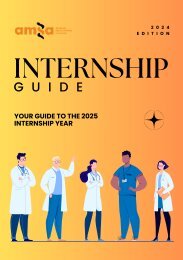AJGH Nexus - Volume 17 2023
AMSA Journal of Global Health (AJGH) 2023 Issue "Nexus"
AMSA Journal of Global Health (AJGH) 2023 Issue "Nexus"
Create successful ePaper yourself
Turn your PDF publications into a flip-book with our unique Google optimized e-Paper software.
AMSA Healthy Communities Article Competition <strong>2023</strong><br />
On the Outskirts<br />
By Lim Yun Fei, Louis<br />
Rare diseases (RDs) encompass diverse conditions, each affecting a small subset of<br />
individuals.[1] Despite their rarity, the collective number of individuals “living<br />
rare” is equivalent to the population of the third largest country.[2]<br />
The limited healthcare accessibility for this marginalised group is a significant<br />
concern as it has adverse health, psychosocial, and economic impacts on patients,<br />
their families, and carers.[1] Major contributing factors include the lack of<br />
awareness, education and professional training about RDs.[3] Furthermore, even<br />
when treatments are available, the costs can be exorbitant. Due to such challenges,<br />
RD patients often undergo long diagnostic journeys, with an average period of 4–5<br />
years.[1] In some cases, it can take over a decade. Despite their extensive and<br />
expensive journeys, RD patients often remain undiagnosed or even misdiagnosed,<br />
which further adds emotional distress to them and their families.[4]<br />
In 2019, the United Nations pledged to alleviate the burden of RDs as part of<br />
achieving universal health coverage. Subsequently, they adopted a resolution in<br />
2021 to recognise the needs and challenges of RD patients and their families,<br />
including healthcare access.[5] This resolution highlights the increasing global<br />
awareness of the unique challenges faced by the RD community and the<br />
importance of equitable healthcare for this marginalised population. Today, I<br />
challenge you to start learning about RDs and to join in creating a more inclusive<br />
and compassionate healthcare system.<br />
References<br />
1. Chung CCY; Hong Kong Genome Project, Chu ATW,<br />
Chung BHY. Rare disease emerging as a global public<br />
health priority. Front Public Health. 2022;10:1028545.<br />
Published 2022 Oct 18. doi:10.3389/fpubh.2022.1028545<br />
10, 1028545. https://doi.org/10.3389/fpubh.2022.1028545<br />
2. EURORDIS. (2021, May). #Resolution4Rare: Global<br />
campaign for the first UN Resolution on Persons Living<br />
with a Rare Disease. Retrieved from:<br />
https://www.eurordis.org/resolution4rare-globalcampaign-for-the-first-un-resolution-<br />
on-personsliving-with-a-rare-disease/<br />
3. Bhattacharya K, Millis N, Jaffe A, Zurynski Y. Rare<br />
diseases research and policy in Australia: On the journey<br />
to equitable care. J Paediatr Child Health. 2021;57(6):778-<br />
781. doi:10.1111/jpc.15507<br />
4. Marwaha S, Knowles JW, Ashley EA. A guide for the<br />
diagnosis of rare and undiagnosed disease: beyond the<br />
exome. Genome Med. 2022;14(1):23. doi:10.1186/s13073-022-<br />
01026-w<br />
5. Adachi T, El-Hattab AW, Jain R, et al. Enhancing<br />
Equitable Access to Rare Disease Diagnosis and Treatment<br />
around the World: A Review of Evidence, Policies, and<br />
Challenges. Int J Environ Res Public Health. <strong>2023</strong>;20(6):4732.<br />
doi:10.3390/ijerph20064732<br />
Appendix:<br />
RD - Rare disease, RDs - Rare diseases, UN - United<br />
Nations

















